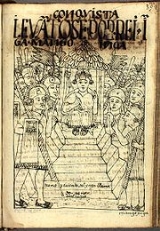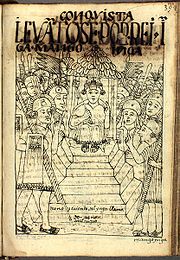
Manco Inca Yupanqui
Encyclopedia

Quechua languages
Quechua is a Native South American language family and dialect cluster spoken primarily in the Andes of South America, derived from an original common ancestor language, Proto-Quechua. It is the most widely spoken language family of the indigenous peoples of the Americas, with a total of probably...
) was one of the Incas of Vilcabamba. He was also known as "Manco II" and "Manco Cápac II" ("Manqu Qhapaq II"). Born in 1516, he was one of the sons of Huayna Cápac
Huayna Capac
Huayna Capac was the eleventh Sapa Inca of the Inca Empire and sixth of the Hanan dynasty. He was the successor to Tupac Inca Yupanqui.-Name:In Quechua, his name is spelled Wayna Qhapaq, and in Southern Quechua, it is Vaina Ghapakh...
and came from a lower class of the nobility.
Túpac Huallpa
Tupac Huallpa
Túpac Huallpa , original name Auqui Huallpa Túpac, was a puppet Inca Emperor of the conquistadors in 1533, during the Spanish conquest of the Inca Empire led by Francisco Pizarro.-Life:...
, a puppet ruler
Puppet state
A puppet state is a nominal sovereign of a state who is de facto controlled by a foreign power. The term refers to a government controlled by the government of another country like a puppeteer controls the strings of a marionette...
crowned by conquistador
Conquistador
Conquistadors were Spanish soldiers, explorers, and adventurers who brought much of the Americas under the control of Spain in the 15th to 16th centuries, following Europe's discovery of the New World by Christopher Columbus in 1492...
Francisco Pizarro
Francisco Pizarro
Francisco Pizarro González, Marquess was a Spanish conquistador, conqueror of the Incan Empire, and founder of Lima, the modern-day capital of the Republic of Peru.-Early life:...
, died in 1533. Manco Inca then approached Francisco Pizarro and Diego de Almagro
Diego de Almagro
Diego de Almagro, , also known as El Adelantado and El Viejo , was a Spanish conquistador and a companion and later rival of Francisco Pizarro. He participated in the Spanish conquest of Peru and is credited as the first European discoverer of Chile.Almagro lost his left eye battling with coastal...
in Cajamarca
Cajamarca
Cajamarca may refer to:Colombia*Cajamarca, Tolima a town and municipality in Tolima DepartmentPeru* Cajamarca, city in Peru.* Cajamarca District, district in the Cajamarca province.* Cajamarca Province, province in the Cajamarca region....
to negotiate a pact, to rule the Inca peoples and Peru
Peru
Peru , officially the Republic of Peru , is a country in western South America. It is bordered on the north by Ecuador and Colombia, on the east by Brazil, on the southeast by Bolivia, on the south by Chile, and on the west by the Pacific Ocean....
since all of the royal nobles were dead. The conquistadors agreed, and in 1534 Manco was crowned the ruler of the Inca in Cuzco
Cusco
Cusco , often spelled Cuzco , is a city in southeastern Peru, near the Urubamba Valley of the Andes mountain range. It is the capital of the Cusco Region as well as the Cuzco Province. In 2007, the city had a population of 358,935 which was triple the figure of 20 years ago...
by Francisco Pizarro, and allowed to rule his people. He did not realize that he too was being used by Pizarro as a puppet ruler for the Spanish
Spain
Spain , officially the Kingdom of Spain languages]] under the European Charter for Regional or Minority Languages. In each of these, Spain's official name is as follows:;;;;;;), is a country and member state of the European Union located in southwestern Europe on the Iberian Peninsula...
conquistadors, who planned to conquer his country and its people.
At first, Manco cooperated with the Spanish, befriending them and offering them gold treasures and women as gifts. However, when Pizarro and de Almagro left Cuzco to explore the northern and southern parts of Peru, he left his younger brothers Gonzalo Pizarro
Gonzalo Pizarro
Gonzalo Pizarro y Alonso was a Spanish conquistador and younger paternal half-brother of Francisco Pizarro, the conqueror of the Inca Empire...
, Juan Pizarro
Juan Pizarro II
Juan Pizarro y Alonso was a Spanish conquistador who accompanied his brothers Francisco, Gonzalo and Hernándo Pizarro for the conquest of Peru in 1532.-Biography:...
and Hernando Pizarro
Hernándo Pizarro
Hernando Pizarro y de Vargas was a Spanish conquistador and one of the Pizarro brothers who ruled over Peru...
as garrisons in the city of Cuzco.
The Pizarro brothers so mistreated Manco Inca that he ultimately tried to escape in December 1535. He failed, was captured and imprisoned but released two months later on the behalf of the Spaniards to please their Inca subjects, heavily dismayed by the fact their factual leader was imprisoned. Under the pretense of performing religious ceremonies in the nearby Yucay valley and recovering golden artifacts for the Spanish occupants, Manco was able to escape from Cuzco on April 18, this time with success.
In order to retake the Empire from the Spanish, Manco gathered an army of 200,000 Inca warriors. Attempting to take advantage of a disagreement between Diego de Almagro and Francisco Pizarro, he marched on the city of Cuzco in 1536 in an attempt to throw the Spaniards out. Although it lasted ten months, the siege was ultimately unsuccessful even though Manco's forces were able to reclaim the city for a few days. Many of Manco Inca's warriors succumbed to smallpox
Smallpox
Smallpox was an infectious disease unique to humans, caused by either of two virus variants, Variola major and Variola minor. The disease is also known by the Latin names Variola or Variola vera, which is a derivative of the Latin varius, meaning "spotted", or varus, meaning "pimple"...
and died (see the siege of Cuzco
Siege of Cuzco
The Siege of Cuzco was the May 6, 1536 – March 1537, ten month siege of the city of Cuzco by the army of Inca Emperor Manco Inca Yupanqui against a garrison of Spanish conquistadors and Indian auxiliaries led by Hernando Pizarro....
).
From 1536–1537, Manco split his forces, adopting a strategy to drive the Spanish invaders out of Peru with an army of 30,000 Inca warriors and attacked the fort of Lima, where Francisco Pizarro was residing. There they met 300 Spanish soldiers and over 20,000 renegade warriors from the Empire, and once again were defeated. The surviving armies retreated to the nearby fortress of Ollantaytambo
Ollantaytambo
Ollantaytambo is a town and an Inca archaeological site in southern Peru some 60 kilometers northwest of the city of Cusco. It is located at an altitude of 2,792 meters above sea level in the district of Ollantaytambo, province of Urubamba, Cusco region...
, from which they had launched several successful attacks against the Spaniards and the Inca renegades, defeating them at the battle of Ollantaytambo
Battle of Ollantaytambo
The Battle of Ollantaytambo took place in January 1537, between the forces of Inca emperor Manco Inca and a Spanish expedition led by Hernando Pizarro during the Spanish conquest of Peru. A former ally of the Spaniards, Manco Inca rebelled in May 1536, and besieged a Spanish garrison in the city...
. But Manco's position at Ollantaytambo was vulnerable due to lack of food because the Inca warriors were actually the same that used to cultivate the fields. The Spanish knew his location, and the region was one day's ride from Cuzco.
Abandoning Ollantaytambo (and effectively giving up the highlands of the empire), Manco Inca retreated to Vitcos
Vitcos
Vitcos is an archaeological site in the Cusco Region in Peru, believed to have been built by ruler in exile Manco Inca during the Spanish conquest of Peru.-History:...
and finally to the remote jungles of Vilcabamba
Vilcabamba, Peru
Vilcabamba was a city founded by Manco Inca in 1539 and was the last refuge of the Inca Empire until it fell to the Spaniards in 1572, signaling the end of Inca resistance to Spanish rule.- History :...
, which became the capital of the empire until the death of Tupaq Amaru in 1572. The Spanish crowned his younger half brother Paullu Inca
Paullu Inca
Paullu Inca was the Sapa Inca of the Inca Empire after the previous Sapa Inca, Manco Inca Yupanqui, rebelled against the Spanish and relocated the empire to Vilcabamba....
as puppet Sapa Inca after his retreat. The Spanish succeeded in capturing Manco's sister-wife, Cura Ocllo
Cura Ocllo
Cura Ocllo was the wife and sister of Manco Inca Yupanqui, puppet and later remnant ruler of the Inca Empire from 1533 until his death in 1544...
, and had her brutally murdered in 1539. After many guerrilla battles in the mountainous regions of Vilcabamba, Manco was murdered in 1544 by supporters of Diego de Almagro who wanted Manco dead, despite his having granted refuge to them. He was succeeded by his son Sayri Tupaq
Sayri Tupac
Sayri Túpac was an Inca ruler in Peru. He was a son of siblings Manco Inca Yupanqui and Cura Ocllo. After the murder of his mother in 1539 and his father in 1544, both by the Spaniard conquerors, he became the ruler of the independent Inca state of Vilcabamba...
.
Manco Inca had several sons, including Sayri Tupaq, Titu Cusi
Titu Cusi
Don Diego de Castro Titu Cusi Yupanqui was a son of Manco Inca Yupanqui, and became the Inca ruler of Vilcabamba, the penultimate leader of the neo-Incan state. He was crowned in 1558, after the death of his half brother, Sayri Tupac...
and Túpac Amaru
Túpac Amaru
Túpac Amaru, also called Thupa Amaro , was the last indigenous leader of the Inca state in Peru.-Accession:...
.
See also
- Spanish conquest of Peru
- Sapa Inca
- Cura OclloCura OclloCura Ocllo was the wife and sister of Manco Inca Yupanqui, puppet and later remnant ruler of the Inca Empire from 1533 until his death in 1544...

